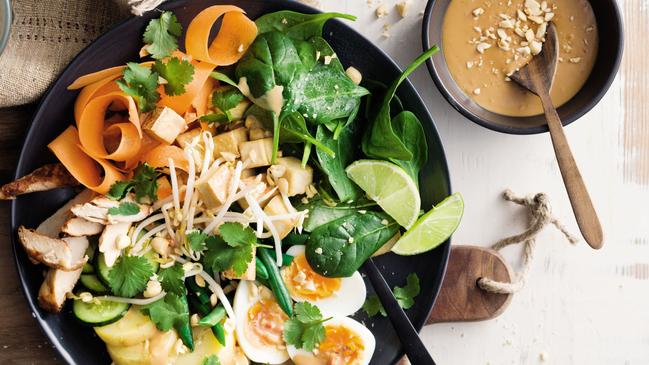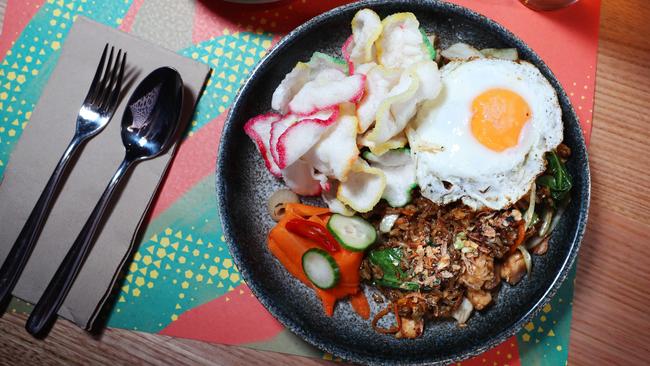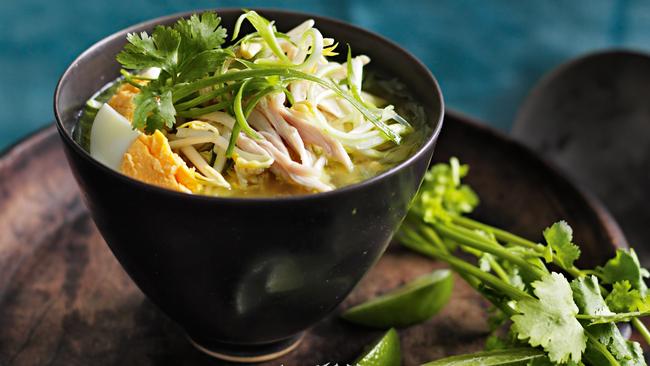How to make Indonesian food beyond mee goreng
Indonesia is so much more than just Bali, Bintang and nasi goreng, offering up some of the world’s most excitingly diverse cuisines. Here’s how to make the most delicious Indonesian food at home.

Eating Out
Don't miss out on the headlines from Eating Out. Followed categories will be added to My News.
We all know one island. But Indonesia is much more than just Bali and Bintang and nasi goreng.
The Indonesian archipelago is the world’s fourth most populous country, with 6000 of more than 17,500 islands populated by more than 264 million people across 300 ethnic groups.
It makes for one of the world’s most excitingly diverse cuisines, varying from region to region, island to island, with influences ranging from Middle Eastern and Indian in Sumatran cooking to Polynesian and Melanesian in the east, with some elements of Chinese – noodles and spring rolls, for instance – incorporated into the cuisine across the country.
“Nobody loves Indonesian food more than Indonesians,” laughs Ubud Food Festival founder Janet de Neefe.
Having called Bali home for more than three decades, the Melbourne expat is currently putting the finishing touches on this year’s festival, the sixth time foodies from across the country will gather in Bali to learn about and celebrate Indonesian cuisine in all its regional glory.

Chefs from Aceh to Ternate, Ambon to Lampung and Semarang and beyond will head to the Ubud hills to share their dishes and stories with an audience of predominantly young Indonesians keen to learn about both the traditions of the regions and the future direction of cuisine in the country.
“I want to bring everyone together, it’s unusual to get the scope of what we’re doing (as a food festival). You don’t see all that different food, so it’s about bringing something to Bali that people don’t normally experience, the theatre of all these other exotic places,” De Neefe says.
For many Australians, Indonesian means mee goreng but there’s a growing band of young chefs here pushing to change that one babi guling (roast suckling pig) at a time.
At Makan – which means “to eat” – Tasia and Gracia Seger (you might remember them from My Kitchen Rules a few years back) are doing an excellent job of elevating Indonesian food above cheap-and-cheerful student fare.
Having grown up in Indonesia, India and Australia, the sisters come from a tight-knit family whose mother and grandmother have informed much of their cooking.
“Grandma has Chinese background, so we do a lot of Indochinese food,” Tasia says. “There are many cultures in Indonesia, lots of influences in the food, but Malay and Chinese are main ones.”
While the Indonesian Ministry of Tourism has declared five “national” foods – nasi goreng (fried rice), rendang (meat braised in coconut milk and spices), gado gado (vegetables with peanut sauce), soto (aromatic soup) and satay – it’s impossible to reduce the nation’s culinary kaleidoscope into one distinct cuisine.

SPICE TEMPLE
“The foundation of the food is spice. The whole archipelago is a spice jungle, so it’s always present in some form,” De Neefe says.
While chilli, turmeric, lemongrass and lime leaves form the foundation of Indonesian cuisine, the diversity in spicing becomes apparent as you move across the country.
From Middle Eastern and Indian influences in the west, Polynesian and Portuguese influences in the east, Indonesia’s indigenous cuisines reflect the archipelago’s history of trade, migration, and colonialism.
The fiery dishes of North Sulawesi brim with Portuguese flavours, while Balinese cuisine, with dishes prepared for ceremonial purposes, is imbued with Hindu spiritualism.
Bumbu is the Indonesian word for the blend of spices. Unlike Indian cooking that favours a dry spice powder mix, Indonesian is similar to Thai in that spices and other aromatic ingredients are ground to a paste using a mortar and pestle.
“Sumatran cuisine is greatly influenced by the Middle East and India. As a result, Sumatran food uses the most spices in the Indonesia archipelago, more than 150 different spices,” Tasia says.
Here, coconut-rich curries are prevalent, such rendang, which are often served with roti, rather than rice.
As you move east across the country, the reliance on coconut is replaced by lighter, fresher flavours using less spices – in the Maluku Islands, for instance, some 30 spices are routinely used.
HELLO MELLOW
“Javanese food is mellower and, in Central Java for example, is sweeter,” Tasia says, with kecap manis (sweet soy sauce) and palm sugar used in many dishes.
“While Javanese cuisine also uses coconut milk or cream, the curries such as opor ayam (chicken in coconut milk) are creamy but do not use as many spices as the Sumatran curries such as gulai, are less thick and a lot more fragrant due to the uses of lemongrass, kaffir lime and galangal.”
Javanese food is also influenced by the Chinese food such as noodles (mie), meatballs (bakso).
PROUD PAPUA
Moving further east, the lighter, cleaner flavours of the Maluku Islands continues into Papua, where fish is eaten in gentle soupy dishes such as ikan kuah kuning – fish in yellow broth – that make use of turmeric, galangal, wild lime and lemongrass.
“This is traditionally eaten with papeda, clear sago porridge,” Tasia says.
Sago, plantains, cassava and corn are other key ingredients, with bakar batu a popular cooking method. Similar to a New Zealand hangi, vegetables such as corn and yams and meat, usually pork, is wrapped in cassava or banana leaves and cooked for hours in an earth pit with hot rocks.

DO THE SAMBAL
With more than 300 different recipes documented across Indonesia, sambal is an essential part of almost every savoury dish – and even some sweet ones. This chilli sauce or paste differs from island to island – in Bali it’s known as sambal matah, and made with chopped shallot, garlic and chilli blended with lime leaves and lemongrass.
MIND YOUR TEMPEH
The only traditional soy food that didn’t originate in China, tempeh has been a staple in Java for centuries – though it’s only recently that vegetarians have discovered its delicious uses.
Fermented soybeans usually found in block form, tempeh is chewy and has a nutty, earthy taste compared with tofu, which is more neutral in flavour. It is usually fried in blocks, or grated like cheese and added to soups.
HEY SATAY
“Satay is different right across Indonesia, there are hundreds of varieties. Each island is like a separate country,” De Neefe says.
Most will be familiar with the traditional skewered meat cooked over coals and served with a peanut sauce, but in Bali, for instance, that meat is pounded with spices, wrapped on a stick, cooked and served without sauce.
Satay marranggi from West Java doesn’t use peanut sauce but flavours the meat with coriander seeds, ginger and kechap manis, while satay padang from West Sumatra uses beef and serves it with a thick yellow sauce of Indian flavours – turmeric, galangal, cumin and curry powder.
BELLY GOOD
To get a real insight into Indonesian cuisine, De Neefe says to head straight to the warungs – small family owned restaurants or cafes – that often specialise in one dish.
“These places usually serve one dish, cook it and serve it, that’s it. There’s nothing sitting around. (Tourists) used to say, you can’t eat in warungs, there was this fear that whatever you ate you were going to get sick,” she says. “These days, you’re more inclined to get sick from eating too much chilli and drinking too much bintang.”

HOT DANG PANDANG
“They call it the queen of Indonesian food, it’s got that Malay thing going on, a bit Arab, a bit Indian. Sumatran food is delicious,” De Neefe says.
At Padang-style restaurants – which come from West Sumatra but are now found all over the country – waiters bring a huge variety of small plates of food to the table, for which you pay for only what you eat.
“People should be brave and try it. Sumatra is the home of rendang, so if people like rendang, they should go to these places,” she says.
YOUNG AND RESTLESS
“The food scene across the country is really dynamic, I think because most of the population is under 30,” De Neefe says.
In Bali “the most fundamental dish to Bali, the one that’s most connected with their identity”’ lawar (a mix of vegetables, coconut and minced meat) is taking on new forms.
“There’s a whole new trend of lawar, which is morphing into new forms using squid or goat or raw tuna. You still get the traditional, but now there’s warungs run by really groovy young Balinese guys who are presenting lawar in a whole new way. You get that right through Indonesia, still have the traditional stuff, prepared by gorgeous old grandmas but then you have things morphing into other shapes and sizes for the young people – but still based in tradition.”
ON THE SAUCE
Gracia Serger says the key to Indonesian cooking can be found bottled in the pantry. Sauces and pastes play an important role in dishes, whether in their creation or served on the side.
1. Kecap Manis (sweet soy sauce)
“This used in almost everything to add sweetness to the dish and it can be used as a substitute of sugar. It’s essential in every Indonesian’s panty.”
2. Sambal ABC
“This is the Indonesian version of sriracha, but it is a lot more spicy – and is served on the side of everything!”
3. Shrimp paste
“This is very important, and used in making many different types of paste, and also to make assorted sambal dishes.”
4. Palm sugar
“This is used to make a thicker caramel and has a very sweet taste.”
5. Turmeric
“Used in making different pastes for curries, soups, rice dishes. It’s also used in a traditional Indonesian drink that’s common, which is good for health and digestion.”
READ MORE:
DINNER BY HESTON BOOTED FROM CROWN
THE ULTIMATE SCHOOL-NIGHT DINNER PLAN
HOW TO MAKE THE BEST FISH N CHIPS AT HOME
CHICKEN GADO GADO SALAD
Serves 4
Prep 15 mins
Cook 15 mins
Recipe Claire Brookman, Super Food Ideas
Picture Andrew Young
INGREDIENTS
500g baby cream delight potatoes
200g green beans, trimmed, halved
4 eggs
2 teaspoons rice bran oil
300g firm tofu, cut into 2cm cubes
1/3 cup smooth peanut butter
1 long red chilli, finely chopped
165ml can light coconut milk
1 1/2 tablespoons kecap manis
1 tablespoon lime juice
1 carrot, peeled into ribbons
1 Lebanese cucumber, sliced into rounds
80g baby spinach
150g packet Steggles Just Eat It oven-roasted chicken slices
1/3 cup bean sprouts, trimmed
2 tablespoons unsalted roasted peanuts, chopped
Fresh coriander leaves, to serve
Lime wedges, to serve
METHOD
STEP 1
Using a fork, prick potatoes all over. Place in a microwave-safe dish with 2 tablespoons water. Cover with plastic wrap. Microwaveon HIGH (100%) for 5 minutes. Add beans. Cover. Microwave on HIGH (100%) for a further 3 minutes or until potatoes are tenderand beans are bright green. Drain. Thickly slice potatoes.
STEP 2
Meanwhile, place eggs in a small saucepan. Cover with cold water. Bring to the boil over high heat. Reduce heat to medium.Simmer gently for 4 minutes. Remove pan from heat. Carefully place eggs under cold running water to cool. Peel eggs and cutin half.
STEP 3
Heat oil in a non-stick frying pan over medium-high heat. Add tofu. Cook, turning, for 2 minutes or until golden. Transferto a paper towel-lined plate. Drain remaining oil from pan. Reduce heat to medium. Add peanut butter, chilli, coconut milkand kecap manis. Cook, stirring, for 5 minutes or until smooth and mixture has thickened slightly. Stir in lime juice.
STEP 4
Arrange potato, beans, carrot, cucumber, spinach, chicken and tofu on plates. Drizzle with sauce and top with sprouts, peanutsand coriander. Serve with lime wedges.


OPOR AYAM: JAVANESE CHICKEN AND COCONUT CURRY
Serves 4
Prep 15 mins
Cook 55 mins
Recipe Katrina Woodman, Taste magazine
Picture Jeremy Simons
INGREDIENTS
1 tablespoon macadamia nuts
1 tablespoon whole coriander seeds
140g red Asian shallots, peeled, coarsely chopped
5cm-piece fresh ginger or galangal, peeled, chopped
4 large garlic cloves, coarsely chopped
1 fresh long red chilli, deseeded, chopped
1 teaspoon grated palm sugar
2 teaspoon water
1 1/2 tablespoon coconut oil
1.2kg chicken pieces
2 lemongrass stalks, bruised, tied into a knot
5 fresh Kaffir lime leaves
1 cinnamon stick
2 x 270ml cans coconut milk
Fried shallots, to serve (optional)
Sliced red chilli, to serve (optional)
Turmeric rice, to serve (see notes)
Lime wedges, to serve (optional)
METHOD
STEP 1
Heat a heavy-based casserole dish over medium-high heat. Cook the macadamia nuts and coriander seeds, stirring, for 2 minutesor until aromatic. Transfer to a mortar and use a pestle to pound until coarsely crushed.
STEP 2
Process macadamia mixture, shallot, ginger, garlic, chilli, sugar and water in a food processor until finely chopped. Season.
STEP 3
Heat 2 tsp oil in the casserole dish over medium-high heat. Season the chicken. Cook in 2 batches, turning, for 8 minutesor until browned. Transfer to a plate. Drain off excess oil.
STEP 4
Heat the remaining oil in the casserole dish over medium-low heat. Cook the shallot mixture, lemongrass, Kaffir lime leavesand cinnamon, stirring, for 5 minutes or until aromatic. Add the chicken. Turn to coat. Add the coconut milk. Reduce heatto low. Cook, covered, stirring occasionally, for 30 minutes or until the chicken is tender. Simmer, uncovered, for 5 minutesor until the sauce has thickened slightly.
STEP 5
Sprinkle with the fried shallots and chilli, if using. Serve with turmeric rice, and lime wedges if using.
NOTES: For turmeric rice, add 1/2 tsp ground turmeric to the rice at the beginning of cooking. To freeze for up to 2 months, coolto room temperature and transfer to an airtight container.
As part of the Melbourne Food and Wine Festival in March, Janet De Neefe will take over the kitchen at Anchovy in Richmond and bring seafood dishes from Sumatra, Bali and Maluku to life over a five-course lunch on March 22.
FOR MORE DETAILS AND BOOKINGS: MFWF.COM.AU
On March 26 and 27, Makan’s Tasia and Gracia Serger will cook traditional dishes from their grandmother’s Javanese kitchen alongside Papuan jungle chef Charles Toto and Sumatran-born culinary anthropologist Rahung Nasution.
The Ubud Food Festival runs 17-19 April. ubudfoodfestival.com

